| Article ID | Journal | Published Year | Pages | File Type |
|---|---|---|---|---|
| 1767126 | Advances in Space Research | 2007 | 10 Pages |
Abstract
Manned mission to space has been threatened by various cosmos risks including radiation, mirogravity, vacuum, confinement, etc., which may cause genetic variations of astronauts and eventually lead to damages of their health. Thus, the development of small biomedical devices, which can monitor astronaut gene expression changes, is useful for future long-term space missions. Using magnetic microbeads packed with nanocrystal quantum dots at controlled ratios, we were able to generate highly multiplexed nanobarcodes, which can encode a flexible panel of genes. Also, by using a reporter quantum dot, this nanobarcode platform can monitor and quantify gene expression level with improved speed and sensitivity. As a comparison, we studied TGF-β1 induced transcription changes in human bone marrow mesenchymal stem cells with both the nanobarcode microbead system and the Affymetrix GeneChip® HTA system, which is currently considered as the industrial standard. Though using only 1/20 of the sample RNA, the nanobarcode system showed sensitivity equivalent to Affymetrix GeneChip® system. The coefficient of variation, dynamic range, and accuracy of the nanobarcodes measurement is equivalent to that of the GeneChip® HTA system. Therefore, this newly invented nanobarcode microbead platform is thought to be sensitive, flexible, cost-effective and accurate in a level equivalent to the conventional methods. As an extension of the use of this new platform, spacecrafts may carry this miniaturized system as a diagnostic tool for the astronauts.
Keywords
Related Topics
Physical Sciences and Engineering
Earth and Planetary Sciences
Space and Planetary Science
Authors
Weiming Ruan, P. Scott Eastman, Patrick A. Cooke, Jennifer S. Park, Julia S.F. Chu, Joe W. Gray, Song Li, Fanqing Frank Chen,
